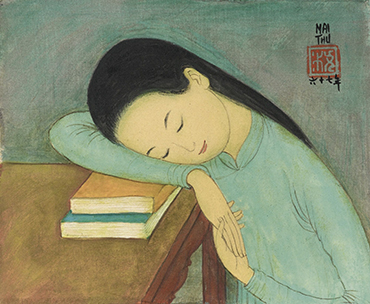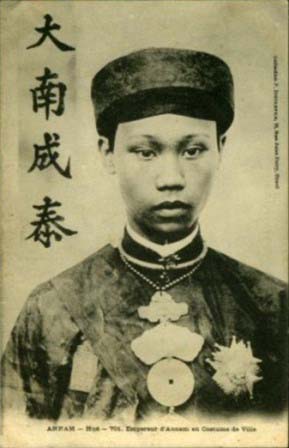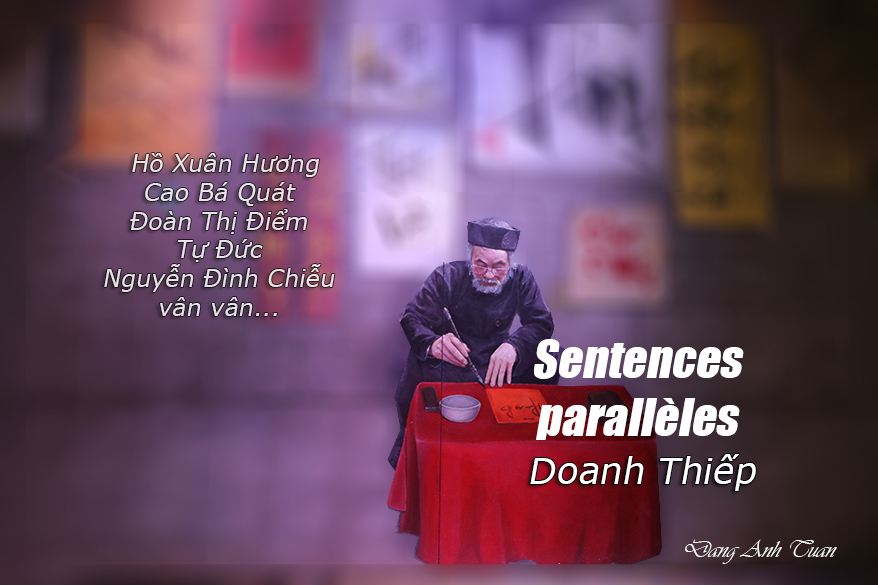 Les traces du régime matriarcal vietnamien
Les traces du régime matriarcal vietnamien
Version française
Version anglaise
Cũng có một thời, dân tộc ta cũng như mọi dân tộc khác ở trên thế giới trải qua chế độ mẫu hệ cả. Có bao giờ chúng ta c ó dịp nghĩ đến vấn đề nầy không? Chắc chắn là không bởi vì khi mới sinh ra, chúng ta đều lấy họ cha cả chỉ có ở Pháp bây giờ mới có quyền thêm họ mẹ vào tên mình. Trong ngôn ngữ tiếng Việt chúng ta thường ngày có dùng những từ ngữ còn giữ tàn tích mẫu hệ mà không bao giờ chúng ta nghĩ đến nhất là từ khi nước ta bước sang qua chế độ phụ hệ từ lâu rồi. Ta thường nói VỢ CHỒNG chớ bao giờ nói CHỒNG VỢ đâu. Lúc nào ta cũng ám chỉ dòng họ bằng hai chữ BÀ CON. Đôi khi còn có sự khinh bỉ trong lời nói của ta khi dùng từ ngữ như « gái nạ dòng » nhất là nạ chỉ dòng mẹ. Theo sự nhận xét của nhà văn Bình Nguyên Lộc thì người ta có hàm ý nói gái đã có nhiều chồng (hay đa phu) tức là gái không tốt đẹp. Tới ngày hôm nay, nước ta vẫn còn chế độ mẫu hệ ở nhiều nơi như ở Tây Nguyên với các tộc người Chăm, Jarai, Êđê, Raglai, Churu thuộc ngữ hệ Nam Đảo (Austronesian) hay là các tộc M’nong, K’ho thuộc ngữ hệ Nam Á. Có người nói nước ta theo chế độ phụ hệ từ khi nước Giao Chỉ bị thôn tính bởi Trung Hoa. Có lẽ là không đúng. Như vậy nước ta từ bỏ chế độ mẫu hệ mà sang chế độ phụ hệ từ lúc nào. Muốn biết vấn đề nầy, các nhà khảo cổ hay thường dựa trên hình thức chôn cất người ở trong các mộ táng của các di chỉ có liên quan đến nền văn hoá trồng lúa nước. Chắc chắn là không phải thời kỳ các Hùng Vương của nước Văn Lang cai trị với nền văn hóa Phùng Nguyên vì viêc nối ngôi (cha truyền con nối) được thấy rõ qua chế độ phụ quyền trong truyền thuyết nhất là quyền lực chủ yếu thuộc về người con trai trưởng với tổ chức xã hội thời bấy giờ.
Chúng ta cũng thừa biết tổ tiên của tộc Việt có nguồn gốc trực tiếp từ vùng sông Dương Tử dựa trên các dữ liệu của các cuộc khảo cứu di truyền ngày nay. Như vậy ta cần phải đi ngược lại thời gian và cần khảo sát ở các nơi có nền văn hóa trồng lúa nước ở trung hay hạ lưu sông Dương Tử. Theo nhà khảo cứu Nhật Shin’ichi Nakamura của đại học Kanazawa thì cái nôi của nền văn hóa trồng lúa nước nó phải nằm ở nơi nầy nhưng với tình trạng hiểu biết hiện nay, chúng ta không thể định vị nó một cách chính xác trên bản đồ. Tuy nhiên có sự tiến hóa xã hội đáng kể ở các vùng hạ lưu sông Dương Tử như ở Hà Mỗ Độ và Lương Chữ trong thời kỳ đồ đá mới bằng cách chuyển sang:
-từ một nền kinh tế đa dạng qua một nền kinh tế độc quyền trồng lúa nước
-từ một môi trường sống nông nghiệp qua sống ở một thành phố
-từ một nghĩa trang tập thể chuyển sang một nghĩa trang của các nhóm người riêng biệt.
Tại sao Hà Mỗ Đồ? Theo sự nhận xét của nhà khảo cổ Pháp Corinne Debaine-Francfort thì ở di chỉ Hà Mỗ Độ người ta khám phá ra không những các tàng tích của một nhà sàn bằng gỗ khác lối nhà bằng đất ở miền bắc Trung Hoa mà có cả luôn các hột lúa được trồng trên những cánh đồng ngập nước bằng cách sử dụng cuốc làm từ vảy động vật vào năm 1973 ở Chiết Giang (Zheijiang). Có thể nói lúa đã được thuần hóa ở nơi nầy có niên đại khoảng chừng từ 4770 năm đến 5000 năm trước Công Nguyên (TCN). Dân cư ở đây có nét đặc trưng của người Mongoloïde và Australo-Négroïde (hay tộc Việt). Khi chết, họ được chôn cất quay đầu về phía đông hoặc đông bắc và hầu hết không có vật lễ táng. Họ cũng không có một nghĩa trang xã xác định rõ ràng mà ngược lại họ có một nghĩa trang thị tộc chung với tài sản tang lễ rất nhiều. Có thể xem ở nơi đây còn chế độ mẫu hệ vì với các di vật động vật như khỉ, tê giác, nai, voi, hổ, qui vân vân… cho ta thấy các cư dân ở đây còn sống với nghề săn bắt và chài lưới. Vai trò của người đàn ông cũng chưa được xem quan trọng bởi vì cũng chưa cần có một tổ chức xã hội cần nhiều nhân lực cho việc sản xuất như chế tạo công cụ, tích trữ gạo ở các vựa lúa, đúc đồng vân vân… cũng như việc phân phối các công việc nặng nhọc để có kết quả mong muốn trong mùa thu gặt. Người đàn ông hầu như rất ít quyền lực và không có quyền sở hữu tài sản.
Ngược lại ở các di chỉ của nền văn hóa Lương Chử thì được thấy sư thay đổi rõ rệt trong sự cân bằng quyền lực giữa chồng và vợ. Thí dụ, trong số các đồ mai táng ở các mộ cá nhân thì các nông cụ như cái xẻng làm bằng đá đẽo thì dành cho nam giới còn bánh xe dệt thì vẫn còn đồ vật chính cho nữ giới.
Như vậy chứng tỏ ở thời đó người đàn ông trở thành công nhân chính ở ngoài ruộng đồng và người đàn bà chỉ còn làm các công việc ở trong nhà. Hơn nữa, còn cho thấy các thợ đá chuyển đổi nghề và trở thành những người thợ đẽo ngọc khiến dẫn đến một giai đoạn quan trọng trong sự phát triển công nghiệp và sự phân chia công việc ở trong xã hội và tạo ra sự phân chia giai cấp giữa người nghèo và người giàu mà luôn cả thành phần qúi tộc và tôn giáo. Từ đó mới có sự góp phần vào sự phân chia trong đơn vị gia đình. Cũng từ đó bắt đầu xuất hiện hình thức một vợ, một chồng, người vợ theo chồng về gia đình nhà chồng, con cái cũng sống chung cùng cha mẹ và gia đình và lấy họ cha lúc mới sinh ra. Khi chết chồng vợ được chôn chung luôn cả người trong gia tộc phụ hệ.
Nói tóm lại chúng ta có thể khẳng định rằng người Việt theo chế độ phụ hệ rất sớm từ khi tổ tiên ta còn ở lưu vực sông Dương Tử. Bởi vậy khi di cư trở về lại đồng bằng sông Hồng, họ vẫn giữ chế độ phụ hệ dưới thời kỳ Hồng Bàng với văn hóa Phùng Nguyên.

Version française
Les traces du régime matriarcal vietnamien
Il y a un temps où notre peuple comme les autres peuples du monde adopte le régime matriarcal. Avons-nous l’occasion de penser à cela par nous-mêmes ? Certainement pas car à la naissance, nous avons tous pris le nom de notre père, sauf en France où nous avons le droit d’ajouter maintenant le nom de notre mère à notre nom. Dans la langue vietnamienne, on se sert souvent des mots qui gardent encore les traces du système matriarcal auquel on ne pense jamais d’autant plus que notre pays a adopté le système patriarcal depuis si longtemps. On dit souvent femme/mari (VỢ CHỒNG) mais jamais mari/femme (CHỒNG VỢ). On est habitué à désigner la lignée familiale avec le terme « BÀ CON » où le mot BÀ (madame) précède toujours le mot CON (ou enfant). Parfois, il y a du mépris dans les propos lorsqu’on emploie le terme suivant « gái nạ dòng ou femme divorcée » où le mot nạ se réfère à la lignée de la mère. Selon la remarque de l’écrivain Binh Nguyên Lộc, on veut insinuer une fille polyandre. Cela veut dire implicitement une mauvaise fille. Jusqu’à ce jour, notre pays continue à avoir encore le régime matriarcal dans de nombreux endroits comme sur les Hauts Plateaux du Vietnam avec les ethnies Cham, Jarai, Ede, Raglai, Churu appartenant à la famille linguistique austronésienne ou les M’nong, les K’ho de la famille des langues austro-asiatiques. Certains prétendent que notre pays a adopté le système patriarcal depuis l’annexion de Jiaozhi (Giao Chỉ) par la Chine.
C’est certainement faux. Alors, depuis quand notre pays a-t-il abandonné le système matriarcal au profit du système patriarcal ? Pour approfondir cette question, les archéologues ont l’habitude de s’appuyer souvent sur la méthode d’inhumation des morts dans les tombes des sites liés à la civilisation de la riziculture inondée. Ce n’est certainement pas l’époque où les rois Hùng du royaume de Văn Lang régnaient avec la culture de Phùng Nguyên car la succession au trône s’opère clairement à travers la patriarchie dans la légende, notamment le pouvoir majeur revenant toujours à l’aîné de la famille dans l’organisation sociale de l’époque. Nous savons également que les ancêtres du peuple vietnamien étaient issus directement de la région du fleuve Bleu (Yang Tsé) en nous basant sur les données des travaux de recherche génétique d’aujourd’hui. Nous devons remonter ainsi le temps et analyser les lieux de culture du riz inondé dans les régions du cours moyen et inférieur du fleuve Yang Tsé car selon le chercheur japonais Shin’ichi Nakamura de l’université Kanazawa, le berceau de la riziculture doit s’y trouver mais en l’état actuel des connaissances, il est difficile de le localiser très précisément sur une carte géographique.
Cependant, il y a l’évolution sociale dans les régions du cours inférieur du fleuve Yang Tsé (sites archéologiques de Hemudu et Liangzhu) au cours de la période néolithique en passant:
-d’une économie diversifiée à une économie exclusivement rizicole
– d’un habitat agricole à un habitat citadin
– d’un cimetière collectif au cimetière des groupes particuliers.
Pourquoi le site de Hemudu? Selon l’archéologue française Corinne Debaine-Francfort, on a trouvé non seulement les restes d’un habitat lacustre en bois monté sur pilotis bien différent des maisons en terre du nord de la Chine mais aussi les grains de riz cultivés dans des champs inondés à l’aide des houes fabriquées à partir d’omoplates d’animaux en 1973 dans le site néolithique le plus ancien de la région de Hemudu (Zheijiang). On peut dire que le riz a été domestiqué dans ce lieu datant d’environ 4770 ans à 5000 ans avant J.C. La population vivant ici possédait des traits à la fois mongoloïde et australo-négroïde. Lors du décès, les gens d’ici étaient enterrés la tête tournée vers l’est ou le nord-est, et n’avaient pour la plupart aucune offrande. Ils n’avaient pas non plus de cimetière communal clairement défini. Par contre ils avaient un cimetière clanique commun avec de nombreux biens funéraires. On peut voir qu’il y a encore ici un système matriarcal car on y trouve les restes d’animaux comme les singes, les rhinocéros, les cerfs, les éléphants, les tigres, les tortues etc. Cela montre que les habitants d’ici vivaient encore de la chasse et de la pêche à cette époque.
Le rôle de l’homme n’est pas considéré important car il n’est pas encore nécessaire d’avoir une organisation sociale réclamant beaucoup de ressources humaines pour la production comme la fabrication d’outils, l’emmagasinage du riz dans les greniers, la fonte du bronze etc… comme la répartition des tâches ardues pour obtenir le résultat souhaité durant la saison des récoltes. L’homme semble avoir peu de pouvoir et n’a pas le droit de posséder ou d’hériter de terres.
En revanche, sur les sites néolithiques de la culture de Liangzhu, il y a un changement manifeste dans l’équilibre des pouvoirs entre mari et femme. Par exemple, parmi les objets funéraires dans les tombes individuelles, les outils agricoles tels que les pelles en pierre polie sont destinées aux hommes et les roues à tisser restent les principaux objets des femmes. Cela prouve qu’à cette époque les hommes constituaient la main d’œuvre principale dans les rizières et les femmes n’assumaient que les travaux ménagers.
De plus, les tailleurs de pierre étaient obligés de changer de métier et ils étaient devenus des tailleurs de jade. Cela a conduit à une période importante du développement industriel et de la division du travail dans la société et a favorisé l’apparition et la distinction de classe entre les pauvres et les riches mais aussi entre l’aristocratie et la religion. Depuis lors, il y a eu aussi une contribution à la division dans la cellule familiale.
C’est aussi à partir de ce moment-là que la monogamie a commencé à apparaître. La femme a suivi son mari pour vivre dans la famille de son mari. Les enfants ont pu vivre également avec leurs parents et leur famille et ont pris désormais le nom de famille du père à leur naissance. Lors du décès, le mari et sa femme pouvaient être enterrés ensemble avec les membres de leur famille patriarcale.
Bref, on peut affirmer que les Vietnamiens ont suivi très tôt le système patriarcal au moment où nos ancêtres vivaient encore dans le bassin du Yang Tsé. Par conséquent, lors de leur retour dans le delta du fleuve Rouge, ils ont continué à conserver le patriarcat sous la dynastie des Hồng Bàng avec la culture de Phùng Nguyên.
Version anglaise
Traces of the Vietnamese matriarchal regime.
There was a time when our people, like other peoples of the world, adopted the matriarchal system. Do we have the opportunity to think about this for ourselves? Certainly not, because at birth, we all took our father’s name, except in France where we now have the right to add our mother’s name to our own. In the Vietnamese language, we often use words that still retain traces of the matriarchal system, which we never think about, especially since our country has adopted the patriarchal system for so long. People often say wife/husband (VỢ CHỒNG) but never husband/wife (CHỒNG VỢ). We are accustomed to designating the family lineage with the term « BÀ CON » where the word BÀ (madam) always precedes the word CON (or child). Sometimes, there is contempt in the words when using the following term « gái nạ dòng » or divorced woman, where the word nạ refers to the mother’s lineage. According to the writer Binh Nguyên Lộc’s remark, it implies a polyandrous girl. This implicitly means a bad girl.
To this day, our country still has the matriarchal system in many places, such as in the Central Highlands of Vietnam with the Cham, Jarai, Ede, Raglai, Churu ethnic groups belonging to the Austronesian language family, or the M’nong, the K’ho of the Austroasiatic language family. Some claim that our country adopted the patriarchal system since the annexation of Jiaozhi (Giao Chỉ) by China.
That is certainly false. So, since when did our country abandon the matriarchal system in favor of the patriarchal system? To delve deeper into this question, archaeologists often rely on the method of burial of the dead in the tombs of sites linked to the civilization of wet-rice cultivation. It is certainly not the era when the Hùng kings of the Văn Lang kingdom ruled with the Phùng Nguyên culture because succession to the throne clearly operated through patriarchy in the legend, notably with major power always going to the eldest in the family within the social organization of the time. We also know that the ancestors of the Vietnamese people came directly from the Blue River (Yangtze) region based on data from current genetic research. We must thus go back in time and analyze the wet-rice cultivation sites in the middle and lower reaches of the Yangtze River because, according to the Japanese researcher Shin’ichi Nakamura from Kanazawa University, the cradle of rice cultivation should be there, but with current knowledge, it is difficult to pinpoint it very precisely on a geographical map.
However, there is social evolution in the lower reaches of the Yangtze River regions (archaeological sites of Hemudu and Liangzhu) during the Neolithic period passing through:
– From a diversified economy to an exclusively rice-based economy
– From an agricultural habitat to an urban habitat
– From a collective cemetery to a cemetery for specific groups.
Why the Hemudu site? According to the French archaeologist Corinne Debaine-Francfort, not only were the remains of a stilted wooden lakeside habitat found, quite different from the earthen houses of northern China, but also rice grains cultivated in flooded fields using hoes made from animal shoulder blades in 1973 at the oldest Neolithic site in the Hemudu region (Zhejiang). It can be said that rice was domesticated at this site dating back approximately 4770 to 5000 years BC. The population living here had both Mongoloid and Australo-Negroid features. Upon death, the people here were buried with their heads turned towards the east or northeast, and most had no offerings. They also did not have a clearly defined communal cemetery. However, they had a common clan cemetery with many funerary goods. It can be seen that there was still a matriarchal system here because remains of animals such as monkeys, rhinoceroses, deer, elephants, tigers, turtles, etc. were found. This shows that the inhabitants still lived by hunting and fishing at that time.
The role of men is not considered important because there is not yet a need for a social organization requiring many human resources for production, such as tool making, storing rice in granaries, bronze smelting, etc., or the distribution of arduous tasks to achieve the desired result during the harvest season. Men seem to have little power and do not have the right to own or inherit land.
On the other hand, at the Neolithic sites of the Liangzhu culture, there is a clear change in the balance of power between husband and wife. For example, among the funerary objects in individual graves, agricultural tools such as polished stone shovels are intended for men, while looms remain the main objects for women. This proves that at that time men constituted the main workforce in the rice fields and women only took on household chores.
Furthermore, stone cutters were forced to change their profession and became jade cutters. This led to an important period of industrial development and division of labor in society and favored the emergence and distinction of classes between the poor and the rich, as well as between the aristocracy and religion. Since then, there has also been a contribution to division within the family unit.
It is also from that moment that monogamy began to appear. The woman followed her husband to live in her husband’s family. The children were also able to live with their parents and family and from then on took their father’s family name at birth. Upon death, the husband and wife could be buried together with the members of their patriarchal family.
In short, it can be affirmed that the Vietnamese followed the patriarchal system very early on when our ancestors were still living in the Yangtze River basin. Consequently, upon their return to the Red River delta, they continued to maintain patriarchy under the Hồng Bàng dynasty with the Phùng Nguyên culture.
Bibliographie:
Annick Levy-Ward : Les centres de diffusion du riz cultivé. De l’Asie du Sud-Est à la Chine. Études rurales, n°151-152, 1999
Shin’ichi Nakamura: LE RIZ, LE JADE ET LA VILLE. Évolution des sociétés néolithiques du Yangzi. Éditions de l’EHESS 2005/5 60e année, pp 1009-1034
Corinne Debaine-Francfort : La redécouverte de la Chine ancienne. Editions Gallimard 1998.
Bình Nguyên Lộc: Lột trần Việt ngữ. Talawas
[Return TRADITIONS]
















